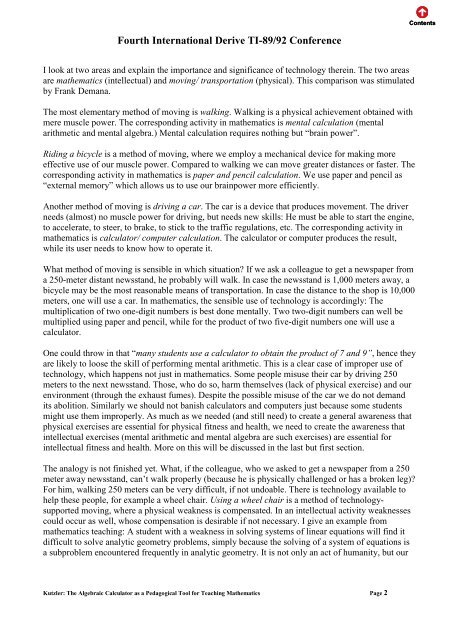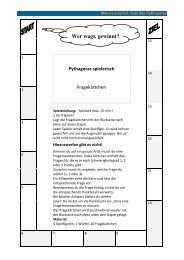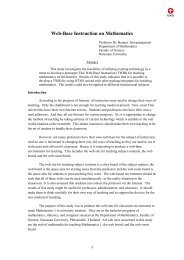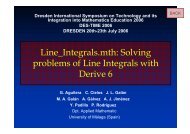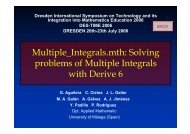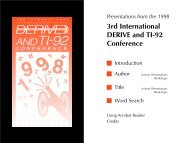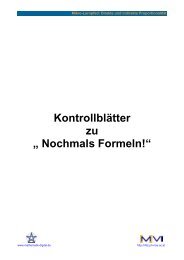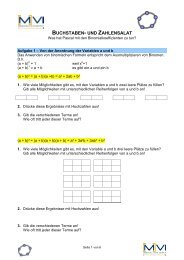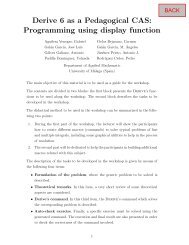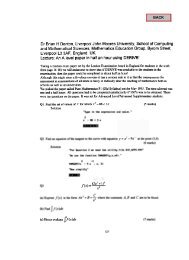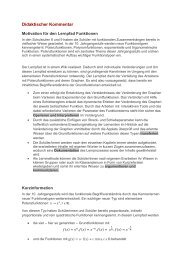The Algebraic Calculator as a Pedagogical Tool for Teaching ...
The Algebraic Calculator as a Pedagogical Tool for Teaching ...
The Algebraic Calculator as a Pedagogical Tool for Teaching ...
Create successful ePaper yourself
Turn your PDF publications into a flip-book with our unique Google optimized e-Paper software.
Fourth International Derive TI-89/92 Conference<br />
I look at two are<strong>as</strong> and explain the importance and significance of technology therein. <strong>The</strong> two are<strong>as</strong><br />
are mathematics (intellectual) and moving/ transportation (physical). This comparison w<strong>as</strong> stimulated<br />
by Frank Demana.<br />
<strong>The</strong> most elementary method of moving is walking. Walking is a physical achievement obtained with<br />
mere muscle power. <strong>The</strong> corresponding activity in mathematics is mental calculation (mental<br />
arithmetic and mental algebra.) Mental calculation requires nothing but “brain power”.<br />
Riding a bicycle is a method of moving, where we employ a mechanical device <strong>for</strong> making more<br />
effective use of our muscle power. Compared to walking we can move greater distances or f<strong>as</strong>ter. <strong>The</strong><br />
corresponding activity in mathematics is paper and pencil calculation. We use paper and pencil <strong>as</strong><br />
“external memory” which allows us to use our brainpower more efficiently.<br />
Another method of moving is driving a car. <strong>The</strong> car is a device that produces movement. <strong>The</strong> driver<br />
needs (almost) no muscle power <strong>for</strong> driving, but needs new skills: He must be able to start the engine,<br />
to accelerate, to steer, to brake, to stick to the traffic regulations, etc. <strong>The</strong> corresponding activity in<br />
mathematics is calculator/ computer calculation. <strong>The</strong> calculator or computer produces the result,<br />
while its user needs to know how to operate it.<br />
What method of moving is sensible in which situation? If we <strong>as</strong>k a colleague to get a newspaper from<br />
a 250-meter distant newsstand, he probably will walk. In c<strong>as</strong>e the newsstand is 1,000 meters away, a<br />
bicycle may be the most re<strong>as</strong>onable means of transportation. In c<strong>as</strong>e the distance to the shop is 10,000<br />
meters, one will use a car. In mathematics, the sensible use of technology is accordingly: <strong>The</strong><br />
multiplication of two one-digit numbers is best done mentally. Two two-digit numbers can well be<br />
multiplied using paper and pencil, while <strong>for</strong> the product of two five-digit numbers one will use a<br />
calculator.<br />
One could throw in that “many students use a calculator to obtain the product of 7 and 9”, hence they<br />
are likely to loose the skill of per<strong>for</strong>ming mental arithmetic. This is a clear c<strong>as</strong>e of improper use of<br />
technology, which happens not just in mathematics. Some people misuse their car by driving 250<br />
meters to the next newsstand. Those, who do so, harm themselves (lack of physical exercise) and our<br />
environment (through the exhaust fumes). Despite the possible misuse of the car we do not demand<br />
its abolition. Similarly we should not banish calculators and computers just because some students<br />
might use them improperly. As much <strong>as</strong> we needed (and still need) to create a general awareness that<br />
physical exercises are essential <strong>for</strong> physical fitness and health, we need to create the awareness that<br />
intellectual exercises (mental arithmetic and mental algebra are such exercises) are essential <strong>for</strong><br />
intellectual fitness and health. More on this will be discussed in the l<strong>as</strong>t but first section.<br />
<strong>The</strong> analogy is not finished yet. What, if the colleague, who we <strong>as</strong>ked to get a newspaper from a 250<br />
meter away newsstand, can’t walk properly (because he is physically challenged or h<strong>as</strong> a broken leg)?<br />
For him, walking 250 meters can be very difficult, if not undoable. <strong>The</strong>re is technology available to<br />
help these people, <strong>for</strong> example a wheel chair. Using a wheel chair is a method of technologysupported<br />
moving, where a physical weakness is compensated. In an intellectual activity weaknesses<br />
could occur <strong>as</strong> well, whose compensation is desirable if not necessary. I give an example from<br />
mathematics teaching: A student with a weakness in solving systems of linear equations will find it<br />
difficult to solve analytic geometry problems, simply because the solving of a system of equations is<br />
a subproblem encountered frequently in analytic geometry. It is not only an act of humanity, but our<br />
Kutzler: <strong>The</strong> <strong>Algebraic</strong> <strong>Calculator</strong> <strong>as</strong> a <strong>Pedagogical</strong> <strong>Tool</strong> <strong>for</strong> <strong>Teaching</strong> Mathematics Page 2


